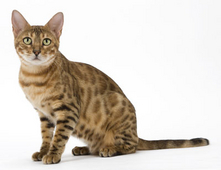The cat is often praised for its ability to regulate food intake according to its needs. However, between 25 and 40% of cats observed by vets show signs of excess weight, so owners need to be careful of the potential for weight gain. It is therefore a good idea to feed diets (such as Health Nutrition™) which lead to significant satiety (a ‘full’ feeling) while moderating energy intakes.
Urban pets
Obesity is a growing concern in domestic cats. This comes down to many factors: the cat is increasingly becoming an urban pet, has limited access to an outside area and is often sterilised. This reduces their energy requirements. An outdoors 4kg cat requires approximately 300kcal/day. Indoors their requirements reduce by a third to 200kcal/day. Furthermore, a sedentary cat who is occasionally offered a high-fat and high-energy diet is less capable of regulating their consumption.
A cat’s health is adversely affected by obesity and excess weight should serve as an early warning sign. Complications include musculoskeletal or joint problems, increased risk of diabetes and sometimes urinary problems. Obese cats can quite often have problems with grooming and dermatological conditions have also been seen with greater frequency. A general trend toward a shorter lifespan is noticed.
How to assess your cat’s weight
Even without weighing your cat, indicators of body condition can be perceived just by stroking and careful observation.
Your cat’s ribs and backbone should not be visible, but easily palpable as you pet them. When looking at the cat in profile or from above, a ‘waist’ should be easily identifiable and their belly should not sag. If the abdomen appears pendulous and full or ‘stretched out’ and you have to search with pressure at your fingertips to find your cat’s ribs you should take action to modify your cat’s weight.
Generally, your cat’s ideal weight is reached at the end of their growth period – between 8 and 12 months of age for most cats. Measuring your cat’s weight at this point may prove to be quite a useful reference point for the rest of your cat’s life. This is your cat’s ‘fit’ weight, which you should strive to maintain whatever your cat’s lifestyle.
The predisposing factors
Relatively sedentary indoor cats are much more likely to develop a weight issue than outdoor cats. Even when well-fed, a cat with access to the outdoors will hunt for an average of four hours per day. You can therefore understand how essential it is for a cat that doesn’t have external access to be able to display these natural behaviours which are linked to their hunting instinct (playing, climbing, jumping, chasing etc).
Boredom and excess weight often go hand in hand, so some environmental enrichment by way of a cat tree, toys and much everyday attention should be given, along with a Health Nutrition™ food suited to an indoor lifestyle. As for “treats”, they should be prohibited unless their caloric content is taken into account when measuring out a daily food allowance.
After neutering or sterilisation a change in hormone balance occurs. One example is that cats have been seen to increase their daily food intake by 20% very quickly when fed free-choice. There is also a reduction in energy expenditure (by 30%) that comes with neutering, increasing the risk of excess weight gain further. Monitor your cat’s weight and combine your efforts with a Health Nutrition™ food which is suited to their new requirements as a sterilised cat. This will help to maintain your cat’s ‘fit’ weight.
